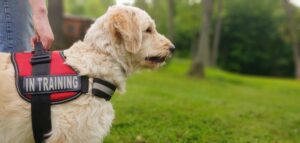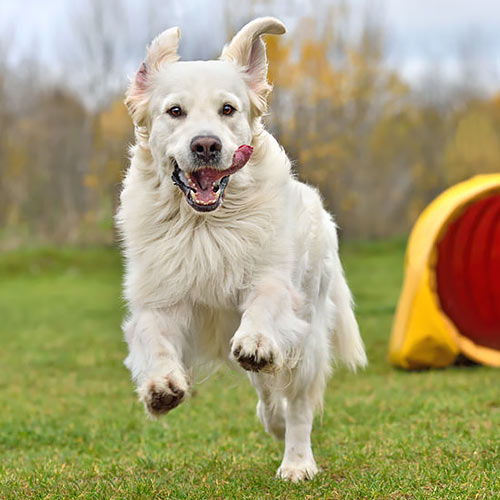Many people are unaware of the vast abilities of service dogs. But, hey, don’t sweat it…we’re here to help!

The purpose of a service dog is to aid a person with disabilities and to reduce the disabled’s dependence upon human intervention. Service dogs provide the disabled with a greater capacity to live independent, “normal” lives (whatever that is, lol) in spite of the disability. Not all disabled people are in a wheelchair or have a red-tipped cane. Many disabled people look like everyone else but underneath they have real needs: such as psychiatric issues, dizziness, or hearing impairment.
Psychiatric Service Dogs
This type of training helps people deal with a wide variety of needs. Dogs trained for PTSD assistance can give relief from panic attacks, awaken their human from nightmares, give a “cushion” between the disabled and a crowd (such as in an elevator). Veterans with combat-related PTSD find increased serenity and less anxiety when these dogs help them to keep calm during sudden loud noises, thunderstorms that sound like explosions, aircraft that bring back memories of an attack, or redirect their attention on to something safe and positive. They can help to keep a person focused on school or work, to get back on track when distracted from reading a book or get back to work on a computer.
Medical Alert Dogs
These dogs are an amazing asset. They can be trained to alert a person to an imminent seizure – before the seizure hits – so that the person can sit down or otherwise prepare for a safe event. They can also aid a person during a seizure, such as laying under the head of the person having the seizure to prevent injury during the event.
Diabetic alert dogs help their humans by notifying either beforehand or when the person is having a glucose event, either a high event or a low event. They can even be trained to alert separately to high and low events so that the person knows exactly what is happening. They can retrieve glucose meters, insulin, and other items needed by the person.
Guide Dogs
These dogs may possibly be the most well-known type of service dog. The vision of the red-tipped cane with a German Shepherd by the side is probably engrained in most all of us. Ancient paintings show dogs guiding blind individuals across busy streets as far back as the 13th century. These dogs help to guide their human away from unsafe hazards such as a hole in the sidewalk, a median in the street, a group of people, or guiding them home, or to the doctor’s office. Guide dogs for the blind are the only type of service dogs that we do not train.
Autism Assistance Dogs
Autism can be difficult for many to cope with, especially some children. Assistance dogs are there to help! These remarkable dogs help kids (and adults) by interrupting harmful behavior (such as head banging or scab picking), keep them focused at school, and provide tons of friendship – which is so important for those who struggle with social skills. The dogs can keep a child from wandering off or, if they do wander off, take the parent to the child. Some people with sensory difficulties can find it helpful to have a service dog take them to an exit in an emergency situation. Adults may need the dog to remind them to take important items with them when leaving the house, such as shoes, keys, or wallet.
Mobility Assistance Dogs
Whether it’s due to medication or a traumatic brain injury, some disabled persons struggle with dizziness, fainting spells, or have physical limitations that require assistance. Some just need an extra boost getting out the wheelchair or crawling out of bed. Usually a larger dog, these canine heroes help to stabilize a person while walking, pull them out of a chair, help them get up after a fall, open a door, retrieve items, or even pulling a wheelchair. They provide stability by using a special harness.
Hearing Alert Dogs
Also called Signal dogs, these guys help a hearing-impaired person by alerting to a ringing telephone, doorbell, alarm clock, when the person’s name is called, and smoke alarms, tornado sirens, train whistles, a baby crying, a car honking in the driveway, or a school bus stopping out front. Due to poor hearing, many hearing-impaired people feel disconnected from family and friends. As a result, alert dogs usually fill a large social need as well. Many people with hearing difficulties have stated that the dog helps them feel more secure and connected.
Conifer Canine Service Dog Training
If you are interested in a service dog, contact us. We often have puppies and young adults who have already learned the basics and are ready to begin their specialized training. We’ll involve you in the selection process, give you a price in writing, and help you begin your journey towards your partnership with a service dog. We’ll be with you the entire way!

